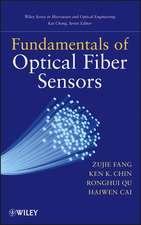Pseudogap and Precursor Superconductivity Study of Zn doped YBCO: Springer Theses
Autor Ece Uykuren Limba Engleză Hardback – 23 mar 2015
A spectral weight (SW) analysis, in which the pseudogap behavior can be separated from the superconducting condensate with the SW transfer to the high-energy region, revealed that the pseudogap is not the precursor of the superconductivity (carriers moving to the high-energy region with pseudogap opening never contribute to the superconducting condensation). Moreover, the high-energy transfer continues even below Tc for the Zn-substituted samples (in which we weaken the superconductivity), which gives evidence to the coexistence of the pseudogap and the superconducting gap below Tc.
On the other hand, the analysis of optical conductivity revealed that a precursor state to superconductivity can be defined at temperatures much higher than Tc. The superconducting carrier density (ns) was calculated for each temperature (above and below Tc) and the results confirmed the existence of ns at temperatures above Tc. The observed real superconducting condensate (ns) above Tc puts a serious constraint on the theory for high- Tc superconductivity. A theory based on an inhomogeneous superconducting state, in which a microscopically phase-separated state in a doped Mott insulator can be observed, is the most plausible candidate. This theory can explain the existence of ns and the observedtemperature range for the precursor superconducting state.
The results obtained show that the pseudogap coexists with superconductivity below Tc and is not the precursor of superconductivity. On the other hand, it is also possible to define a precursor superconducting state that is different than the pseudogap. The temperature range and the observed superconducting condensate in this state can be explained with the help of the inhomogeneous superconducting state.
| Toate formatele și edițiile | Preț | Express |
|---|---|---|
| Paperback (1) | 544.80 lei 38-44 zile | |
| Springer – 9 oct 2016 | 544.80 lei 38-44 zile | |
| Hardback (1) | 637.28 lei 43-57 zile | |
| Springer – 23 mar 2015 | 637.28 lei 43-57 zile |
Din seria Springer Theses
- 18%
 Preț: 997.88 lei
Preț: 997.88 lei -
 Preț: 389.88 lei
Preț: 389.88 lei - 15%
 Preț: 646.94 lei
Preț: 646.94 lei - 18%
 Preț: 943.43 lei
Preț: 943.43 lei -
 Preț: 399.29 lei
Preț: 399.29 lei - 18%
 Preț: 944.99 lei
Preț: 944.99 lei - 15%
 Preț: 636.80 lei
Preț: 636.80 lei - 18%
 Preț: 941.05 lei
Preț: 941.05 lei - 15%
 Preț: 643.16 lei
Preț: 643.16 lei - 15%
 Preț: 642.68 lei
Preț: 642.68 lei - 18%
 Preț: 1103.62 lei
Preț: 1103.62 lei - 20%
 Preț: 558.82 lei
Preț: 558.82 lei - 18%
 Preț: 1112.30 lei
Preț: 1112.30 lei - 18%
 Preț: 944.19 lei
Preț: 944.19 lei - 18%
 Preț: 1109.92 lei
Preț: 1109.92 lei - 18%
 Preț: 1217.27 lei
Preț: 1217.27 lei - 15%
 Preț: 640.06 lei
Preț: 640.06 lei - 15%
 Preț: 636.45 lei
Preț: 636.45 lei - 15%
 Preț: 640.06 lei
Preț: 640.06 lei - 15%
 Preț: 640.88 lei
Preț: 640.88 lei -
 Preț: 389.70 lei
Preț: 389.70 lei - 20%
 Preț: 563.89 lei
Preț: 563.89 lei -
 Preț: 393.35 lei
Preț: 393.35 lei - 15%
 Preț: 637.93 lei
Preț: 637.93 lei - 15%
 Preț: 641.85 lei
Preț: 641.85 lei - 18%
 Preț: 1225.94 lei
Preț: 1225.94 lei - 20%
 Preț: 551.36 lei
Preț: 551.36 lei - 18%
 Preț: 1229.10 lei
Preț: 1229.10 lei - 15%
 Preț: 639.25 lei
Preț: 639.25 lei - 18%
 Preț: 999.45 lei
Preț: 999.45 lei - 15%
 Preț: 640.06 lei
Preț: 640.06 lei - 18%
 Preț: 1220.45 lei
Preț: 1220.45 lei - 18%
 Preț: 1116.26 lei
Preț: 1116.26 lei - 18%
 Preț: 1110.72 lei
Preț: 1110.72 lei - 18%
 Preț: 1000.87 lei
Preț: 1000.87 lei - 18%
 Preț: 891.17 lei
Preț: 891.17 lei - 15%
 Preț: 640.06 lei
Preț: 640.06 lei - 5%
 Preț: 1154.07 lei
Preț: 1154.07 lei - 15%
 Preț: 635.96 lei
Preț: 635.96 lei - 15%
 Preț: 640.88 lei
Preț: 640.88 lei -
 Preț: 387.20 lei
Preț: 387.20 lei - 18%
 Preț: 1109.92 lei
Preț: 1109.92 lei -
 Preț: 385.25 lei
Preț: 385.25 lei -
 Preț: 385.25 lei
Preț: 385.25 lei - 18%
 Preț: 1112.30 lei
Preț: 1112.30 lei - 18%
 Preț: 999.45 lei
Preț: 999.45 lei -
 Preț: 386.99 lei
Preț: 386.99 lei - 15%
 Preț: 637.13 lei
Preț: 637.13 lei - 20%
 Preț: 554.20 lei
Preț: 554.20 lei - 20%
 Preț: 555.57 lei
Preț: 555.57 lei
Preț: 637.28 lei
Preț vechi: 749.73 lei
-15% Nou
Puncte Express: 956
Preț estimativ în valută:
121.95€ • 127.64$ • 101.50£
121.95€ • 127.64$ • 101.50£
Carte tipărită la comandă
Livrare economică 31 martie-14 aprilie
Preluare comenzi: 021 569.72.76
Specificații
ISBN-13: 9784431555094
ISBN-10: 4431555099
Pagini: 108
Ilustrații: XIII, 93 p. 79 illus., 54 illus. in color.
Dimensiuni: 155 x 235 x 12 mm
Greutate: 0.33 kg
Ediția:2015
Editura: Springer
Colecția Springer
Seria Springer Theses
Locul publicării:Tokyo, Japan
ISBN-10: 4431555099
Pagini: 108
Ilustrații: XIII, 93 p. 79 illus., 54 illus. in color.
Dimensiuni: 155 x 235 x 12 mm
Greutate: 0.33 kg
Ediția:2015
Editura: Springer
Colecția Springer
Seria Springer Theses
Locul publicării:Tokyo, Japan
Public țintă
ResearchCuprins
Introduction.- High Temperature Cuprate Superconductors.- Experimental Procedure.- Results and Discussion.- Conclusion.
Notă biografică
Dr. Ece UYKUR
Experimental Physics II, Augsburg University, Universitätstrasse 1, D-86159 Augsburg, Germany.
Experimental Physics II, Augsburg University, Universitätstrasse 1, D-86159 Augsburg, Germany.
Textul de pe ultima copertă
In this thesis, the pseudogap and the precursor superconducting state, which are of great importance in clarifying the superconductivity mechanism in high-temperature cuprate superconductors, are investigated with a c-axis optical study in YBa2(Cu1-xZnx)3Oy. Testing was performed over a wide energy range with smaller temperature intervals for several Zn-substituted samples, as well as for several carrier-doping levels.
A spectral weight (SW) analysis, in which the pseudogap behavior can be separated from the superconducting condensate with the SW transfer to the high-energy region, revealed that the pseudogap is not the precursor of the superconductivity (carriers moving to the high-energy region with pseudogap opening never contribute to the superconducting condensation). Moreover, the high-energy transfer continues even below Tc for the Zn-substituted samples (in which we weaken the superconductivity), which gives evidence to the coexistence of the pseudogap and the superconducting gap below Tc.
On the other hand, the analysis of optical conductivity revealed that a precursor state to superconductivity can be defined at temperatures much higher than Tc. The superconducting carrier density (ns) was calculated for each temperature (above and below Tc) and the results confirmed the existence of ns at temperatures above Tc. The observed real superconducting condensate (ns) above Tc puts a serious constraint on the theory for high- Tc superconductivity. A theory based on an inhomogeneous superconducting state, in which a microscopically phase-separated state in a doped Mott insulator can be observed, is the most plausible candidate. This theory can explain the existence of ns and the observed temperature range for the precursor superconducting state.
The results obtained show that the pseudogap coexists with superconductivity below Tc and is not the precursor of superconductivity. On the other hand, it is also possible to define a precursor superconducting state that is different than the pseudogap. The temperature range and the observed superconducting condensate in this state can be explained with the help of the inhomogeneous superconducting state.
A spectral weight (SW) analysis, in which the pseudogap behavior can be separated from the superconducting condensate with the SW transfer to the high-energy region, revealed that the pseudogap is not the precursor of the superconductivity (carriers moving to the high-energy region with pseudogap opening never contribute to the superconducting condensation). Moreover, the high-energy transfer continues even below Tc for the Zn-substituted samples (in which we weaken the superconductivity), which gives evidence to the coexistence of the pseudogap and the superconducting gap below Tc.
On the other hand, the analysis of optical conductivity revealed that a precursor state to superconductivity can be defined at temperatures much higher than Tc. The superconducting carrier density (ns) was calculated for each temperature (above and below Tc) and the results confirmed the existence of ns at temperatures above Tc. The observed real superconducting condensate (ns) above Tc puts a serious constraint on the theory for high- Tc superconductivity. A theory based on an inhomogeneous superconducting state, in which a microscopically phase-separated state in a doped Mott insulator can be observed, is the most plausible candidate. This theory can explain the existence of ns and the observed temperature range for the precursor superconducting state.
The results obtained show that the pseudogap coexists with superconductivity below Tc and is not the precursor of superconductivity. On the other hand, it is also possible to define a precursor superconducting state that is different than the pseudogap. The temperature range and the observed superconducting condensate in this state can be explained with the help of the inhomogeneous superconducting state.
Caracteristici
Discusses the coexistence of the pseudogap and the superconducting gap in the superconducting state. Presents the temperature and doping dependencies of the precursor superconducting state Investigates the validity of the proposed theories based on the experimental results. Nominated as an outstanding contribution by Osaka University's Physics Department in 2013. Includes supplementary material: sn.pub/extras







